Marijuana Use and Attitudes: A Critical Analysis of Research Findings
VerifiedAdded on 2022/08/27
|7
|1493
|13
Case Study
AI Summary
This case study presents a critical analysis of a research article focusing on marijuana consumption among college students. The analysis begins with an overview of the problem, highlighting the significance of the topic as a public health issue, and the background information provided by the authors. The study's methodology, including the use of quantitative data collected through surveys, is examined, along with the ethical considerations and participant selection. The analysis also evaluates the instruments used, the study design, and the results, including the statistical presentation of findings. The discussion section is critically reviewed, including the conclusions drawn and recommendations made by the researchers. The analysis also addresses the limitations of the study and suggests areas for future research, such as expanding the sample size and exploring potential solutions to address the identified issues.
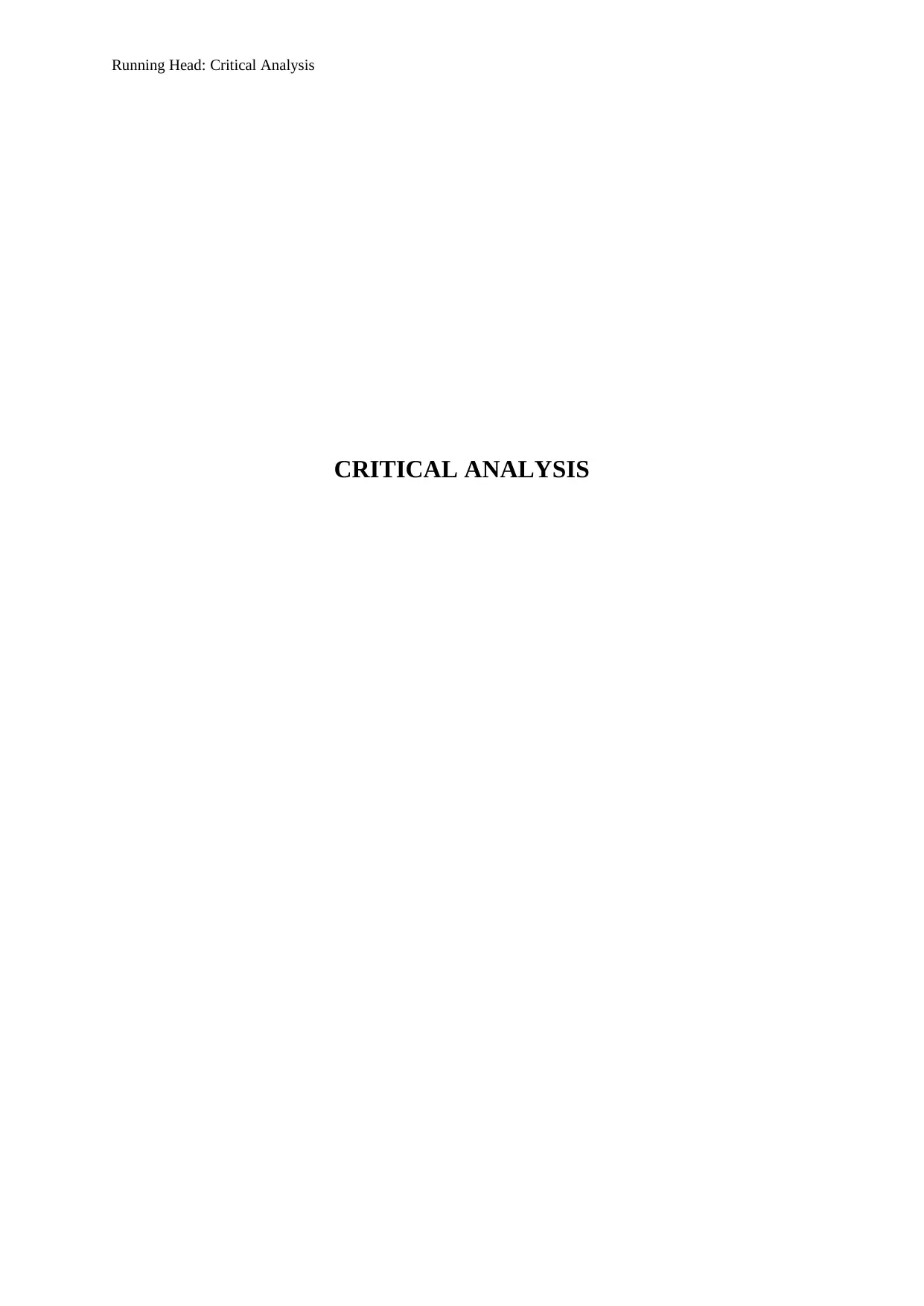
Running Head: Critical Analysis
CRITICAL ANALYSIS
CRITICAL ANALYSIS
Paraphrase This Document
Need a fresh take? Get an instant paraphrase of this document with our AI Paraphraser
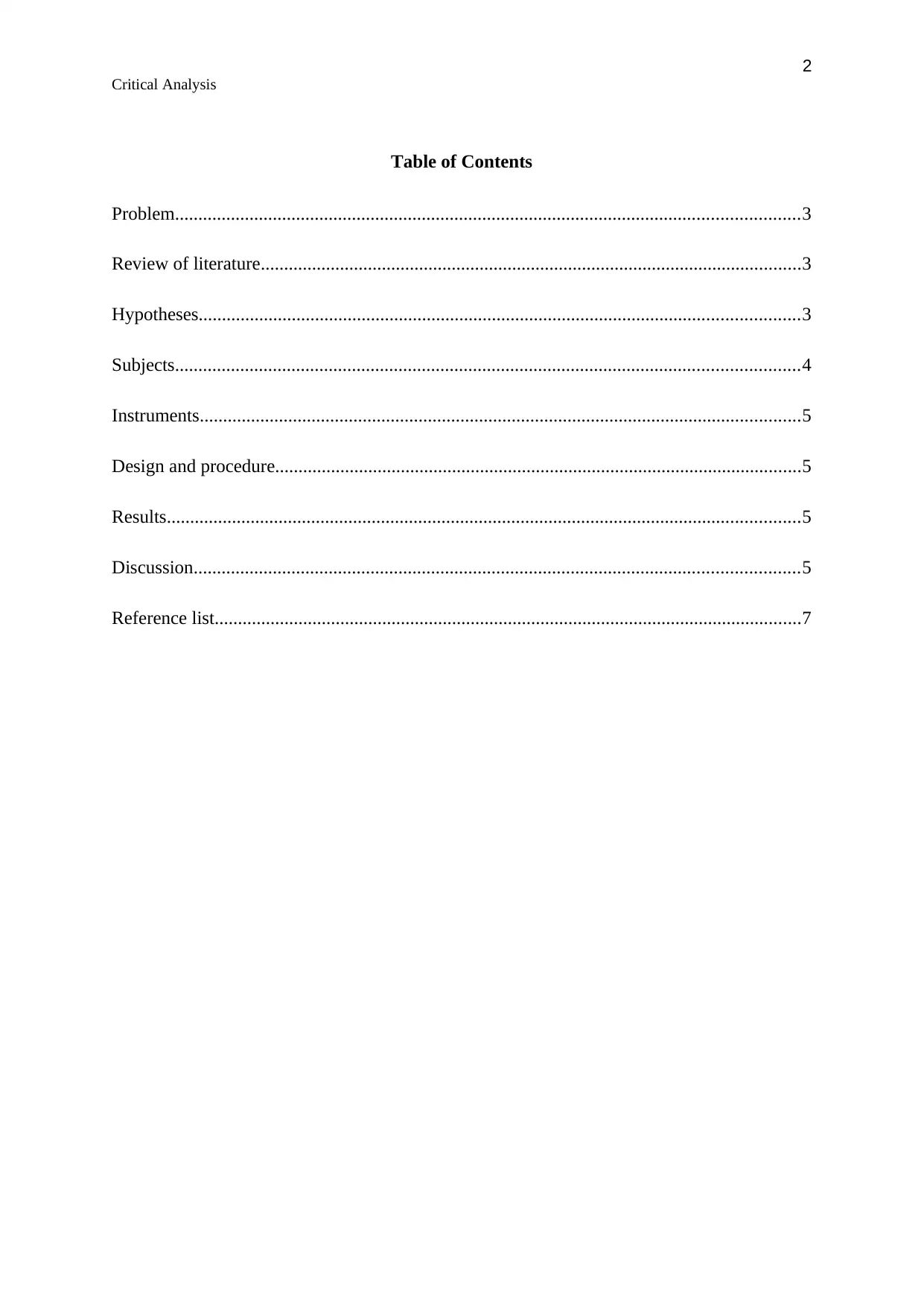
2
Critical Analysis
Table of Contents
Problem......................................................................................................................................3
Review of literature....................................................................................................................3
Hypotheses.................................................................................................................................3
Subjects......................................................................................................................................4
Instruments.................................................................................................................................5
Design and procedure.................................................................................................................5
Results........................................................................................................................................5
Discussion..................................................................................................................................5
Reference list..............................................................................................................................7
Critical Analysis
Table of Contents
Problem......................................................................................................................................3
Review of literature....................................................................................................................3
Hypotheses.................................................................................................................................3
Subjects......................................................................................................................................4
Instruments.................................................................................................................................5
Design and procedure.................................................................................................................5
Results........................................................................................................................................5
Discussion..................................................................................................................................5
Reference list..............................................................................................................................7
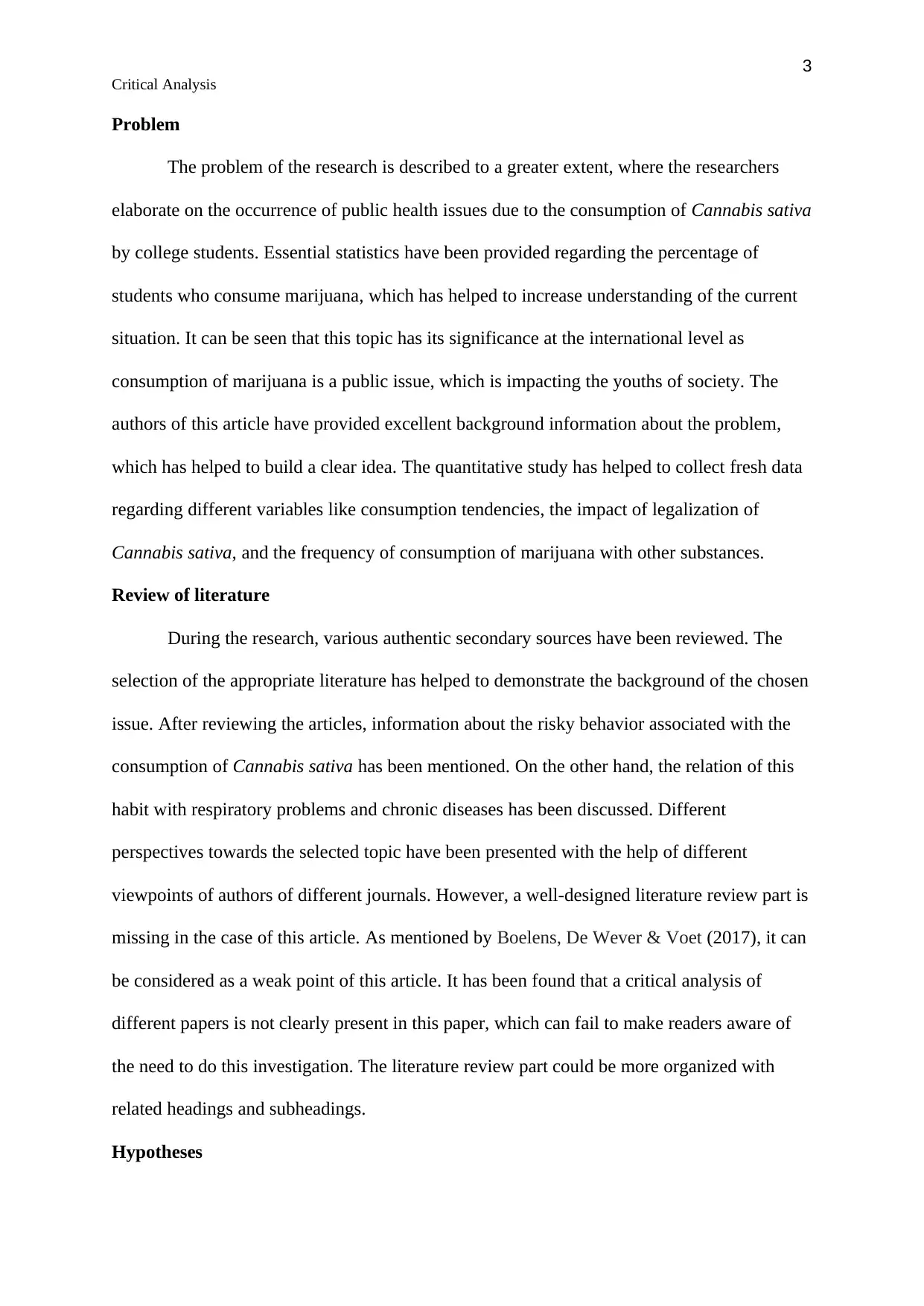
3
Critical Analysis
Problem
The problem of the research is described to a greater extent, where the researchers
elaborate on the occurrence of public health issues due to the consumption of Cannabis sativa
by college students. Essential statistics have been provided regarding the percentage of
students who consume marijuana, which has helped to increase understanding of the current
situation. It can be seen that this topic has its significance at the international level as
consumption of marijuana is a public issue, which is impacting the youths of society. The
authors of this article have provided excellent background information about the problem,
which has helped to build a clear idea. The quantitative study has helped to collect fresh data
regarding different variables like consumption tendencies, the impact of legalization of
Cannabis sativa, and the frequency of consumption of marijuana with other substances.
Review of literature
During the research, various authentic secondary sources have been reviewed. The
selection of the appropriate literature has helped to demonstrate the background of the chosen
issue. After reviewing the articles, information about the risky behavior associated with the
consumption of Cannabis sativa has been mentioned. On the other hand, the relation of this
habit with respiratory problems and chronic diseases has been discussed. Different
perspectives towards the selected topic have been presented with the help of different
viewpoints of authors of different journals. However, a well-designed literature review part is
missing in the case of this article. As mentioned by Boelens, De Wever & Voet (2017), it can
be considered as a weak point of this article. It has been found that a critical analysis of
different papers is not clearly present in this paper, which can fail to make readers aware of
the need to do this investigation. The literature review part could be more organized with
related headings and subheadings.
Hypotheses
Critical Analysis
Problem
The problem of the research is described to a greater extent, where the researchers
elaborate on the occurrence of public health issues due to the consumption of Cannabis sativa
by college students. Essential statistics have been provided regarding the percentage of
students who consume marijuana, which has helped to increase understanding of the current
situation. It can be seen that this topic has its significance at the international level as
consumption of marijuana is a public issue, which is impacting the youths of society. The
authors of this article have provided excellent background information about the problem,
which has helped to build a clear idea. The quantitative study has helped to collect fresh data
regarding different variables like consumption tendencies, the impact of legalization of
Cannabis sativa, and the frequency of consumption of marijuana with other substances.
Review of literature
During the research, various authentic secondary sources have been reviewed. The
selection of the appropriate literature has helped to demonstrate the background of the chosen
issue. After reviewing the articles, information about the risky behavior associated with the
consumption of Cannabis sativa has been mentioned. On the other hand, the relation of this
habit with respiratory problems and chronic diseases has been discussed. Different
perspectives towards the selected topic have been presented with the help of different
viewpoints of authors of different journals. However, a well-designed literature review part is
missing in the case of this article. As mentioned by Boelens, De Wever & Voet (2017), it can
be considered as a weak point of this article. It has been found that a critical analysis of
different papers is not clearly present in this paper, which can fail to make readers aware of
the need to do this investigation. The literature review part could be more organized with
related headings and subheadings.
Hypotheses
⊘ This is a preview!⊘
Do you want full access?
Subscribe today to unlock all pages.

Trusted by 1+ million students worldwide
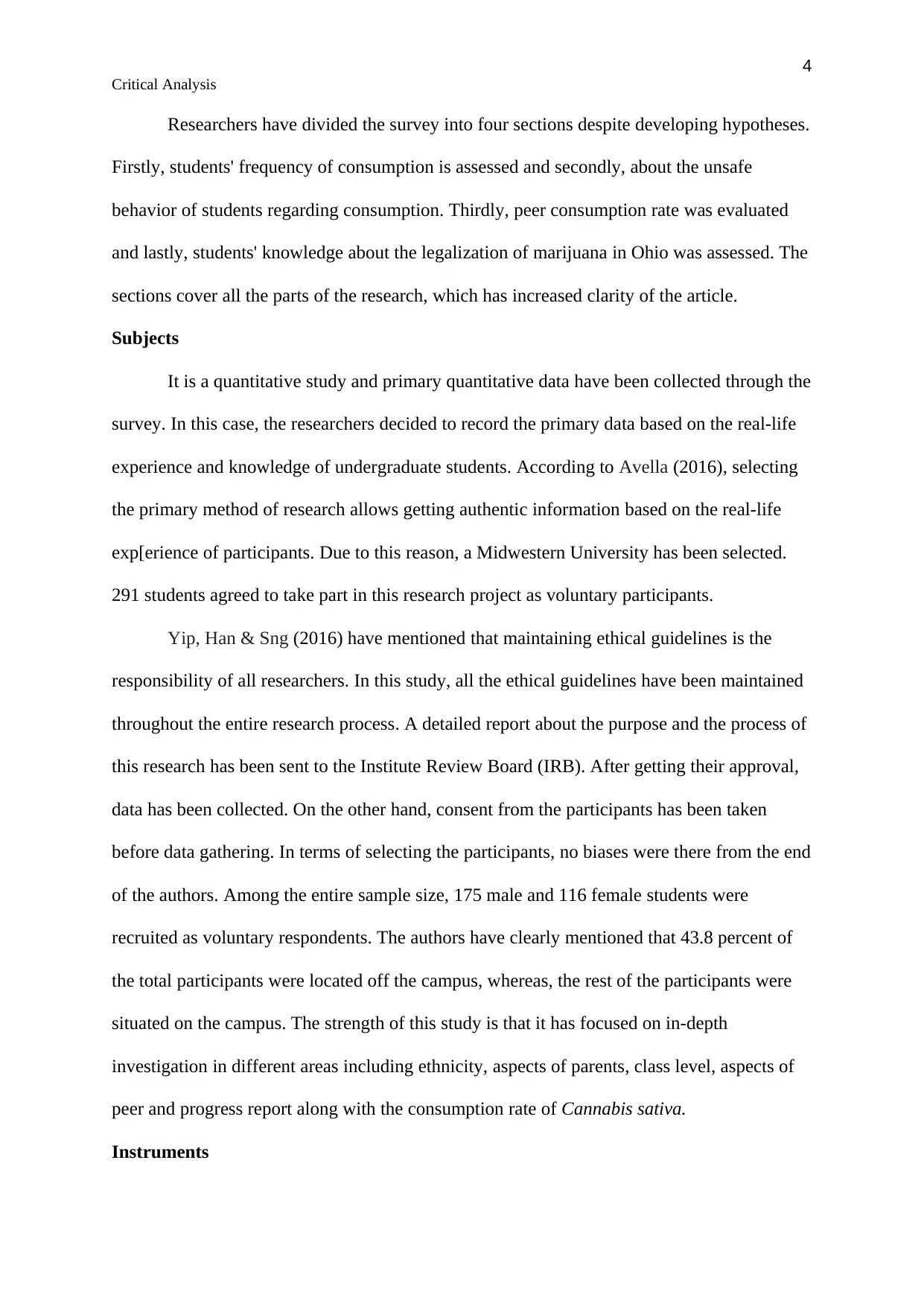
4
Critical Analysis
Researchers have divided the survey into four sections despite developing hypotheses.
Firstly, students' frequency of consumption is assessed and secondly, about the unsafe
behavior of students regarding consumption. Thirdly, peer consumption rate was evaluated
and lastly, students' knowledge about the legalization of marijuana in Ohio was assessed. The
sections cover all the parts of the research, which has increased clarity of the article.
Subjects
It is a quantitative study and primary quantitative data have been collected through the
survey. In this case, the researchers decided to record the primary data based on the real-life
experience and knowledge of undergraduate students. According to Avella (2016), selecting
the primary method of research allows getting authentic information based on the real-life
exp[erience of participants. Due to this reason, a Midwestern University has been selected.
291 students agreed to take part in this research project as voluntary participants.
Yip, Han & Sng (2016) have mentioned that maintaining ethical guidelines is the
responsibility of all researchers. In this study, all the ethical guidelines have been maintained
throughout the entire research process. A detailed report about the purpose and the process of
this research has been sent to the Institute Review Board (IRB). After getting their approval,
data has been collected. On the other hand, consent from the participants has been taken
before data gathering. In terms of selecting the participants, no biases were there from the end
of the authors. Among the entire sample size, 175 male and 116 female students were
recruited as voluntary respondents. The authors have clearly mentioned that 43.8 percent of
the total participants were located off the campus, whereas, the rest of the participants were
situated on the campus. The strength of this study is that it has focused on in-depth
investigation in different areas including ethnicity, aspects of parents, class level, aspects of
peer and progress report along with the consumption rate of Cannabis sativa.
Instruments
Critical Analysis
Researchers have divided the survey into four sections despite developing hypotheses.
Firstly, students' frequency of consumption is assessed and secondly, about the unsafe
behavior of students regarding consumption. Thirdly, peer consumption rate was evaluated
and lastly, students' knowledge about the legalization of marijuana in Ohio was assessed. The
sections cover all the parts of the research, which has increased clarity of the article.
Subjects
It is a quantitative study and primary quantitative data have been collected through the
survey. In this case, the researchers decided to record the primary data based on the real-life
experience and knowledge of undergraduate students. According to Avella (2016), selecting
the primary method of research allows getting authentic information based on the real-life
exp[erience of participants. Due to this reason, a Midwestern University has been selected.
291 students agreed to take part in this research project as voluntary participants.
Yip, Han & Sng (2016) have mentioned that maintaining ethical guidelines is the
responsibility of all researchers. In this study, all the ethical guidelines have been maintained
throughout the entire research process. A detailed report about the purpose and the process of
this research has been sent to the Institute Review Board (IRB). After getting their approval,
data has been collected. On the other hand, consent from the participants has been taken
before data gathering. In terms of selecting the participants, no biases were there from the end
of the authors. Among the entire sample size, 175 male and 116 female students were
recruited as voluntary respondents. The authors have clearly mentioned that 43.8 percent of
the total participants were located off the campus, whereas, the rest of the participants were
situated on the campus. The strength of this study is that it has focused on in-depth
investigation in different areas including ethnicity, aspects of parents, class level, aspects of
peer and progress report along with the consumption rate of Cannabis sativa.
Instruments
Paraphrase This Document
Need a fresh take? Get an instant paraphrase of this document with our AI Paraphraser
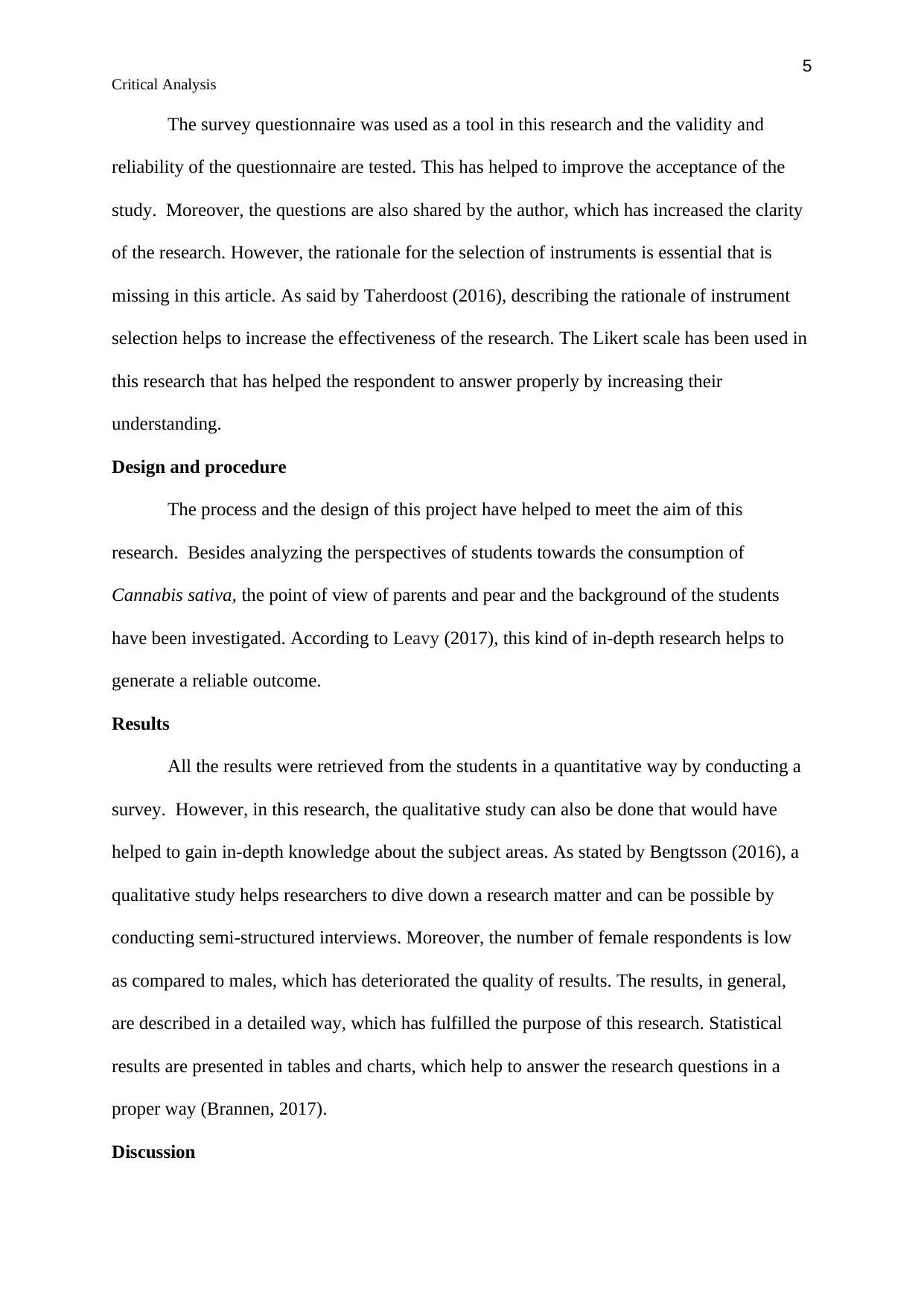
5
Critical Analysis
The survey questionnaire was used as a tool in this research and the validity and
reliability of the questionnaire are tested. This has helped to improve the acceptance of the
study. Moreover, the questions are also shared by the author, which has increased the clarity
of the research. However, the rationale for the selection of instruments is essential that is
missing in this article. As said by Taherdoost (2016), describing the rationale of instrument
selection helps to increase the effectiveness of the research. The Likert scale has been used in
this research that has helped the respondent to answer properly by increasing their
understanding.
Design and procedure
The process and the design of this project have helped to meet the aim of this
research. Besides analyzing the perspectives of students towards the consumption of
Cannabis sativa, the point of view of parents and pear and the background of the students
have been investigated. According to Leavy (2017), this kind of in-depth research helps to
generate a reliable outcome.
Results
All the results were retrieved from the students in a quantitative way by conducting a
survey. However, in this research, the qualitative study can also be done that would have
helped to gain in-depth knowledge about the subject areas. As stated by Bengtsson (2016), a
qualitative study helps researchers to dive down a research matter and can be possible by
conducting semi-structured interviews. Moreover, the number of female respondents is low
as compared to males, which has deteriorated the quality of results. The results, in general,
are described in a detailed way, which has fulfilled the purpose of this research. Statistical
results are presented in tables and charts, which help to answer the research questions in a
proper way (Brannen, 2017).
Discussion
Critical Analysis
The survey questionnaire was used as a tool in this research and the validity and
reliability of the questionnaire are tested. This has helped to improve the acceptance of the
study. Moreover, the questions are also shared by the author, which has increased the clarity
of the research. However, the rationale for the selection of instruments is essential that is
missing in this article. As said by Taherdoost (2016), describing the rationale of instrument
selection helps to increase the effectiveness of the research. The Likert scale has been used in
this research that has helped the respondent to answer properly by increasing their
understanding.
Design and procedure
The process and the design of this project have helped to meet the aim of this
research. Besides analyzing the perspectives of students towards the consumption of
Cannabis sativa, the point of view of parents and pear and the background of the students
have been investigated. According to Leavy (2017), this kind of in-depth research helps to
generate a reliable outcome.
Results
All the results were retrieved from the students in a quantitative way by conducting a
survey. However, in this research, the qualitative study can also be done that would have
helped to gain in-depth knowledge about the subject areas. As stated by Bengtsson (2016), a
qualitative study helps researchers to dive down a research matter and can be possible by
conducting semi-structured interviews. Moreover, the number of female respondents is low
as compared to males, which has deteriorated the quality of results. The results, in general,
are described in a detailed way, which has fulfilled the purpose of this research. Statistical
results are presented in tables and charts, which help to answer the research questions in a
proper way (Brannen, 2017).
Discussion
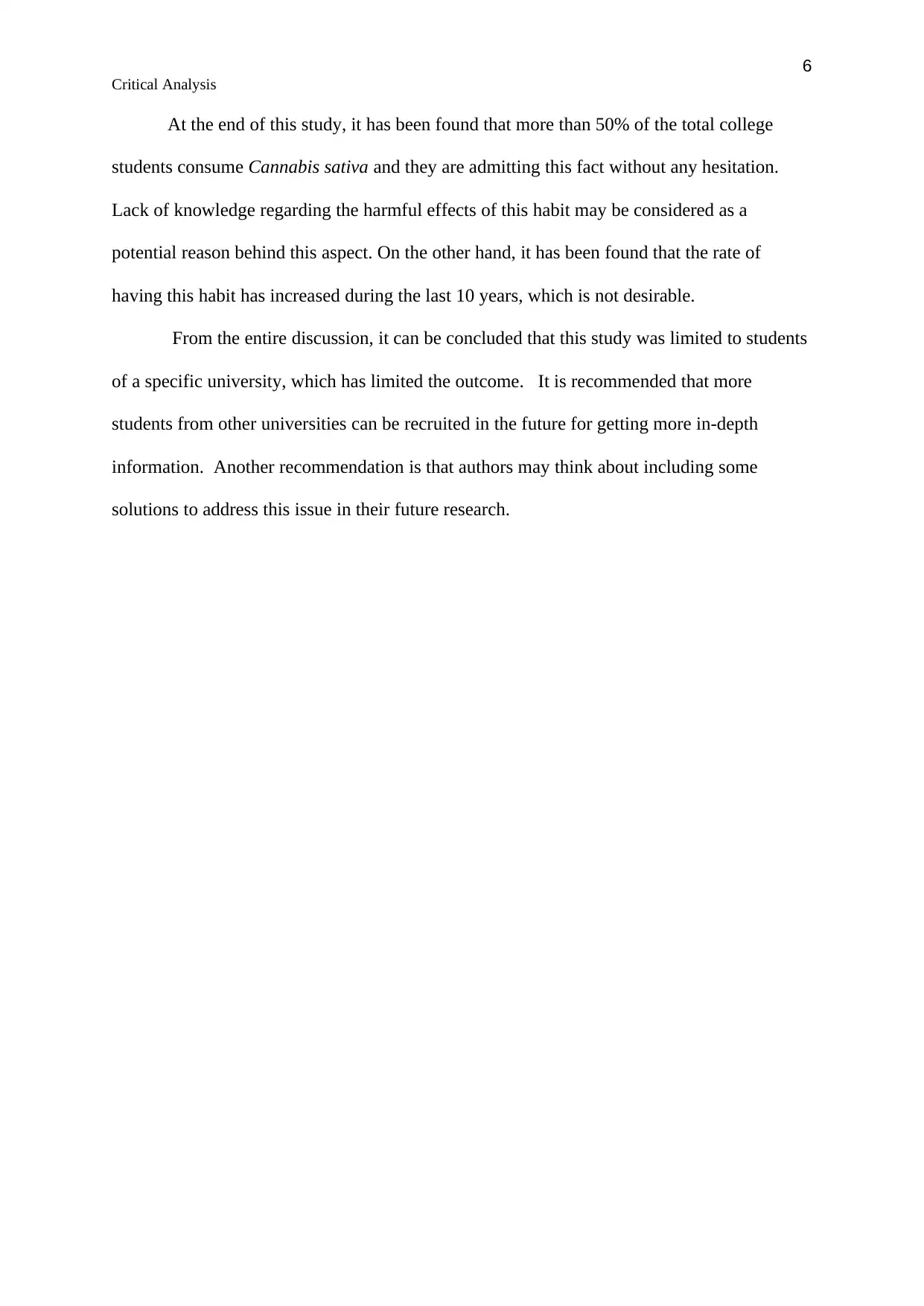
6
Critical Analysis
At the end of this study, it has been found that more than 50% of the total college
students consume Cannabis sativa and they are admitting this fact without any hesitation.
Lack of knowledge regarding the harmful effects of this habit may be considered as a
potential reason behind this aspect. On the other hand, it has been found that the rate of
having this habit has increased during the last 10 years, which is not desirable.
From the entire discussion, it can be concluded that this study was limited to students
of a specific university, which has limited the outcome. It is recommended that more
students from other universities can be recruited in the future for getting more in-depth
information. Another recommendation is that authors may think about including some
solutions to address this issue in their future research.
Critical Analysis
At the end of this study, it has been found that more than 50% of the total college
students consume Cannabis sativa and they are admitting this fact without any hesitation.
Lack of knowledge regarding the harmful effects of this habit may be considered as a
potential reason behind this aspect. On the other hand, it has been found that the rate of
having this habit has increased during the last 10 years, which is not desirable.
From the entire discussion, it can be concluded that this study was limited to students
of a specific university, which has limited the outcome. It is recommended that more
students from other universities can be recruited in the future for getting more in-depth
information. Another recommendation is that authors may think about including some
solutions to address this issue in their future research.
⊘ This is a preview!⊘
Do you want full access?
Subscribe today to unlock all pages.

Trusted by 1+ million students worldwide
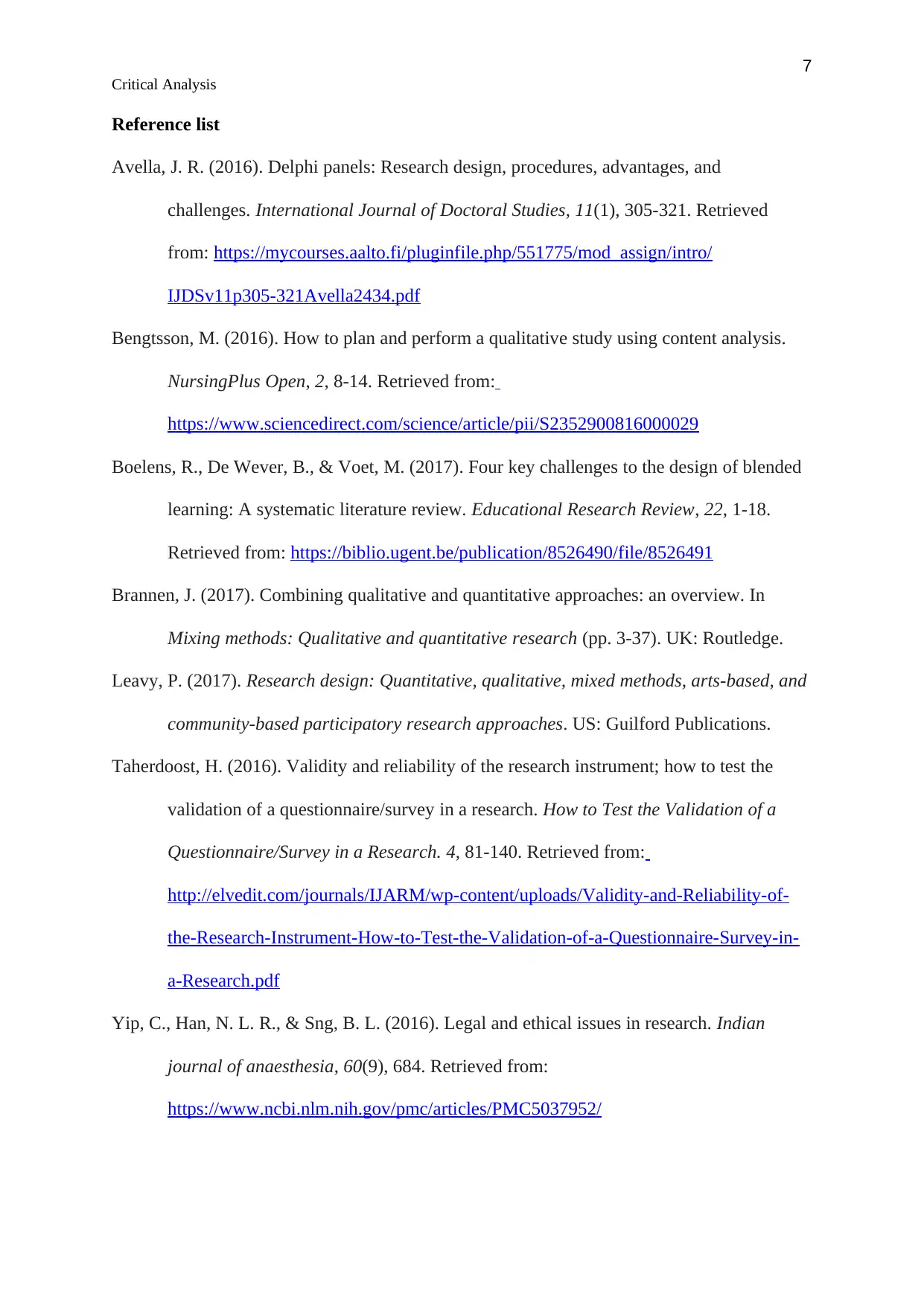
7
Critical Analysis
Reference list
Avella, J. R. (2016). Delphi panels: Research design, procedures, advantages, and
challenges. International Journal of Doctoral Studies, 11(1), 305-321. Retrieved
from: https://mycourses.aalto.fi/pluginfile.php/551775/mod_assign/intro/
IJDSv11p305-321Avella2434.pdf
Bengtsson, M. (2016). How to plan and perform a qualitative study using content analysis.
NursingPlus Open, 2, 8-14. Retrieved from:
https://www.sciencedirect.com/science/article/pii/S2352900816000029
Boelens, R., De Wever, B., & Voet, M. (2017). Four key challenges to the design of blended
learning: A systematic literature review. Educational Research Review, 22, 1-18.
Retrieved from: https://biblio.ugent.be/publication/8526490/file/8526491
Brannen, J. (2017). Combining qualitative and quantitative approaches: an overview. In
Mixing methods: Qualitative and quantitative research (pp. 3-37). UK: Routledge.
Leavy, P. (2017). Research design: Quantitative, qualitative, mixed methods, arts-based, and
community-based participatory research approaches. US: Guilford Publications.
Taherdoost, H. (2016). Validity and reliability of the research instrument; how to test the
validation of a questionnaire/survey in a research. How to Test the Validation of a
Questionnaire/Survey in a Research. 4, 81-140. Retrieved from:
http://elvedit.com/journals/IJARM/wp-content/uploads/Validity-and-Reliability-of-
the-Research-Instrument-How-to-Test-the-Validation-of-a-Questionnaire-Survey-in-
a-Research.pdf
Yip, C., Han, N. L. R., & Sng, B. L. (2016). Legal and ethical issues in research. Indian
journal of anaesthesia, 60(9), 684. Retrieved from:
https://www.ncbi.nlm.nih.gov/pmc/articles/PMC5037952/
Critical Analysis
Reference list
Avella, J. R. (2016). Delphi panels: Research design, procedures, advantages, and
challenges. International Journal of Doctoral Studies, 11(1), 305-321. Retrieved
from: https://mycourses.aalto.fi/pluginfile.php/551775/mod_assign/intro/
IJDSv11p305-321Avella2434.pdf
Bengtsson, M. (2016). How to plan and perform a qualitative study using content analysis.
NursingPlus Open, 2, 8-14. Retrieved from:
https://www.sciencedirect.com/science/article/pii/S2352900816000029
Boelens, R., De Wever, B., & Voet, M. (2017). Four key challenges to the design of blended
learning: A systematic literature review. Educational Research Review, 22, 1-18.
Retrieved from: https://biblio.ugent.be/publication/8526490/file/8526491
Brannen, J. (2017). Combining qualitative and quantitative approaches: an overview. In
Mixing methods: Qualitative and quantitative research (pp. 3-37). UK: Routledge.
Leavy, P. (2017). Research design: Quantitative, qualitative, mixed methods, arts-based, and
community-based participatory research approaches. US: Guilford Publications.
Taherdoost, H. (2016). Validity and reliability of the research instrument; how to test the
validation of a questionnaire/survey in a research. How to Test the Validation of a
Questionnaire/Survey in a Research. 4, 81-140. Retrieved from:
http://elvedit.com/journals/IJARM/wp-content/uploads/Validity-and-Reliability-of-
the-Research-Instrument-How-to-Test-the-Validation-of-a-Questionnaire-Survey-in-
a-Research.pdf
Yip, C., Han, N. L. R., & Sng, B. L. (2016). Legal and ethical issues in research. Indian
journal of anaesthesia, 60(9), 684. Retrieved from:
https://www.ncbi.nlm.nih.gov/pmc/articles/PMC5037952/
1 out of 7
Related Documents
Your All-in-One AI-Powered Toolkit for Academic Success.
+13062052269
info@desklib.com
Available 24*7 on WhatsApp / Email
![[object Object]](/_next/static/media/star-bottom.7253800d.svg)
Unlock your academic potential
Copyright © 2020–2025 A2Z Services. All Rights Reserved. Developed and managed by ZUCOL.





